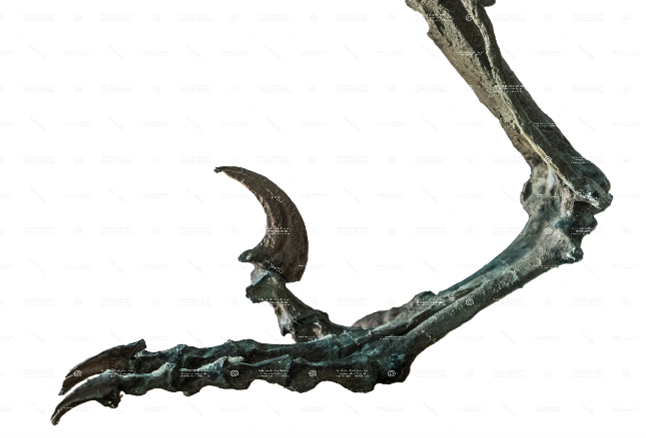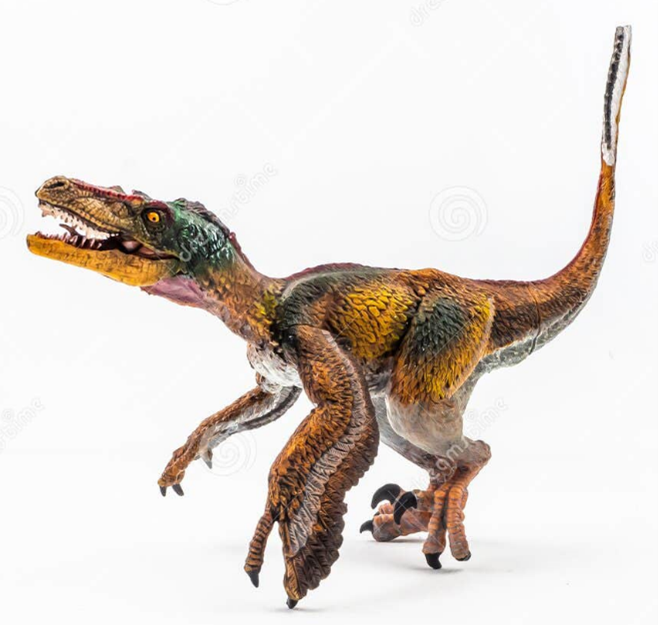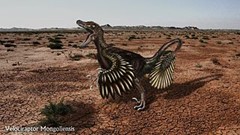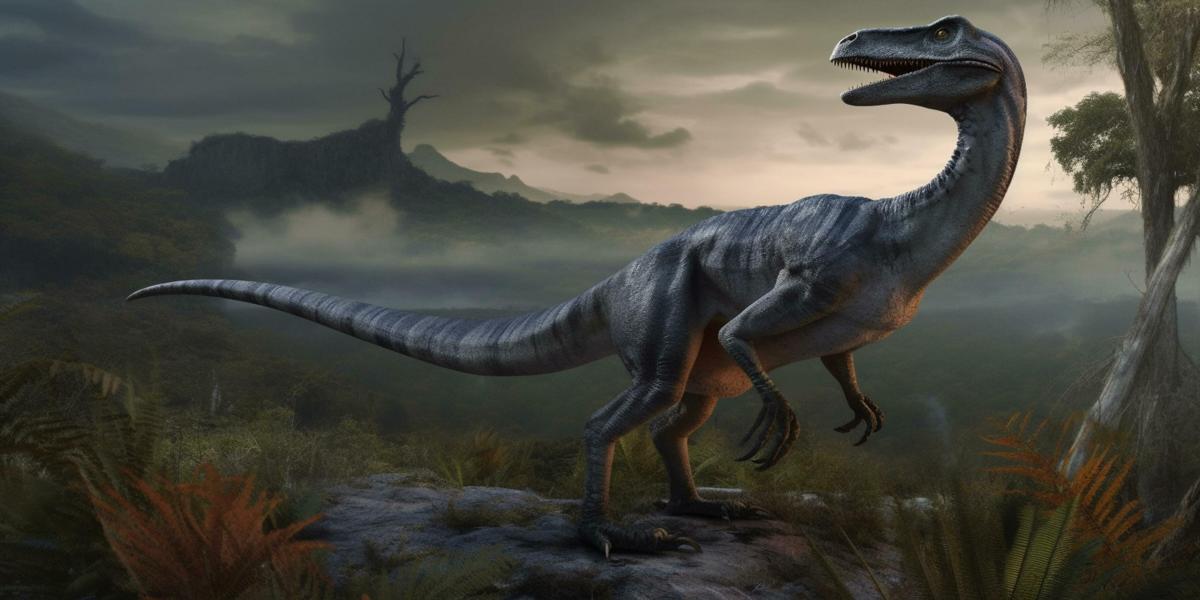
In the first movie of the Jurassic Park series, the second scariest dinosaur was Velociraptor. (Scariest? T-rex, of course.) The movie showed a creature that was about six feet tall, with a huge foot claw that it held upright. Its body was thick, like a tyrannosaur, it was highly intelligent, and it hunted in a pack during the day. Given that most of us like watching movies with scary creatures, a star was born. Overnight Velociraptor became famous.
But like many movies, Jurassic Park got it wrong. In fact, pretty much all of it was wrong. To start with, Velociraptor was little: only about three feet tall (one meter) measured at the hip. From the tip of its nose to the end of its tail, it measured about six feet (2 meters), but almost half of that length was its long, stiff tail. When Velociraptor was fully grown, it weighed only about 33 pounds (15 kg). A Great Dane, which is about the same height, can weigh up to 140 pounds (64 kg.).
Why is the height of a dinosaur measured at its hip? (Click Me)
Dinosaurs that walked on two legs didn’t stand upright. They leaned forward (sometimes a little, sometimes a lot) and used their tail to balance their head. This means that the head wouldn’t always be at the same height. It could go up and down. But the legs of dinosaurs are directly under their bodies, so the measurement of height at the hip would always be the same.
The movie showed Velociraptor covered with scales, but scientists have found marks on the arm and tail bones of this dinosaur that show feathers were attached there. In fact, it’s likely their whole bodies were covered with feathers. However, though their arms may have looked like wings, Velociraptors weren’t capable of flight. Their arms were too short, and their bodies were too long. Instead, they walked on two legs.

If you’re now picturing a fluffy, cute, little dinosaur, think again. It would not make a good pet. It may have been only about the size of a Great Dane, but it was a fierce hunter. Its upright, sickle (curved in an arc) claw was about 2½ inches (6.5 cm.) long, measured around the outer edge. That’s not very big compared to that claw in the movies, but an eagle’s talons are only two inches long, and think of the damage it can do with those!
The movie did get it right that Velociraptor was a carnivore, a meat eater. It had a mouth full of very sharp, serrated (having a jagged edge , like a steak knife) teeth. Its head was flat with large eyes that enabled it to see very clearly. It also had great senses of smell and hearing. The three claws on each hand were very sharp. Each foot had sharp claws, too, including that famous sickle claw. This claw was held up off the ground, which kept it very sharp. Claws that scrape along the ground become dull.
The movie showed a highly intelligent, coordinated attack by a pack of Velociraptors in the daytime. However, none of that is true. First, Velociraptor was not that smart. Its brain was large compared to its body, but it’s a small body and a small brain. It was about as smart as a bird of prey, such as a hawk. Many modern mammals could have outthought it.
Next, it probably wasn’t a pack hunter. Strangely, it is their teeth that make some scientists think this. Scientists have analyzed the teeth of young Velociraptors and compared them to adult Velociraptors. They’ve found that the chemicals in each set of teeth are different. This is important information because in pack animals the chemical makeup of the teeth is usually the same because old and young share the same food.

Young animals which are not taken care of by their parents or the pack usually have different chemicals in their teeth than adults because they eat different food. They would eat lizards and insects, small creatures that a little dinosaur could catch. As an adult they’d eat bigger things. Young animals that have not been taken care of by their parents also tend not to hang out with others of their kind. And, dinosaurs are more closely related to reptiles and birds which generally do not hunt in packs. So, at least for right now, these facts have caused scientists to lean toward the theory that Velociraptor did not hunt in packs.

But whichever way it goes, it is certain that Velociraptor’s slim body and long legs made it a fast runner. It could run as fast as a roadrunner, maybe as fast as 25 mph (40 kph). Small prey, with their short legs, didn’t stand a chance of outrunning it. Their only chance of escaping lay in having a big head start because Velociraptor’s leg muscles weren’t strong enough to run really fast over a long distance.
Sometimes Velociraptor is shown in books and movies using its sickle claw to rip open its prey, but that isn’t likely. The claw could break through the skin of a dinosaur, but tests show it wasn’t strong enough or long enough to kill another animal. Most likely that claw was used to hold onto its prey while Velociraptor used its other claws and its teeth to kill. Hawks and various other birds of prey use their talons in this way.
Velociraptors also probably hunted at night, not in the day as in Jurassic Park. Scientists have noted that all birds and many reptiles alive today have a ring of bone around the eye. In those animals that hunt at night, the opening in the ring is large, to let in as much light as possible. Those that hunt in the day have a much smaller opening. Velociraptor has a large opening in its ring of bone. This makes it almost certain that it hunted at night. And that makes sense as the area Velociraptor lived in was mostly desert. It would want to hunt at night when it would be cooler. Its body wouldn’t overheat, and small creatures would be more likely to come out.
All in all, Velociraptor is not much like the creature in the movie that made it famous, but the real Velociraptor was still a deadly predator.
Which do you like better? The real Velociraptor or the one in the movie? Please let me know in the comments below.
Sources (Click Me)
“Dinosaurs: Where Jurassic Park Got It Wrong.” The Guardian. Theguardian.com. 8 Feb. 2009. https://www.theguardian.com/science/2009/feb/08/jurassic-park-dinosaur-inaccuracies
Hendry, Lisa. “Vicious Velociraptor: Tales of a Turkey-sized Dinosaur.” Natural History Museum London. https://www.nhm.ac.uk/discover/velociraptor-facts.html.
Maxwell, W. Desmond, and John H. Ostrom. “Taphonomy and Paleobiological Implications of Tenontosaurus-Deinonychus Associations.” Journal of Vertebrate Paleontology, vol. 15, no. 4, [Society of Vertebrate Paleontology, Taylor & Francis, Ltd.], 1995, pp. 707–12, http://www.jstor.org/stable/4523664.
Osterloff, Emily. “Were Dinosaurs Good Parents?” Natural History Museum London. n.d. https://www.nhm.ac.uk/discover/were-dinosaurs-good-parents.html
Switek, Brian. “Dinosaurs Behaving Badly: Did Velociraptors Hunt in Packs?” 29 March 2011. The Guardian. https://www.theguardian.com/science/blog/2011/mar/29/dinosaurs-behaviour-raptors-pack-hunters
Taylor, Ian. “The Scary Truth about Velociraptors.” Science Focus. BBC Focus Magazine. 30 May 2021. https://www.sciencefocus.com/nature/the-scary-truth-about-velociraptors/
“Velociraptor Had Feathers, Scientists Say.” CBS News. 20 Sept. 2007. https://www.cbc.ca/news/science/velociraptor-had-feathers-scientists-say-1.686873
Yong, Ed. “How We Know Velociraptor Hunted by Night.” National Geographic. 14 April 2021. https://www.nationalgeographic.com/science/article/dinosaurs-around-the-clock-or-how-we-know-velociraptor-hunted-by-night
First feathered dinosaur from Dreamstime, paid for July 15, 2023
